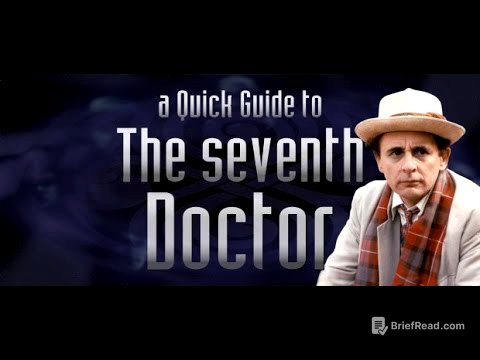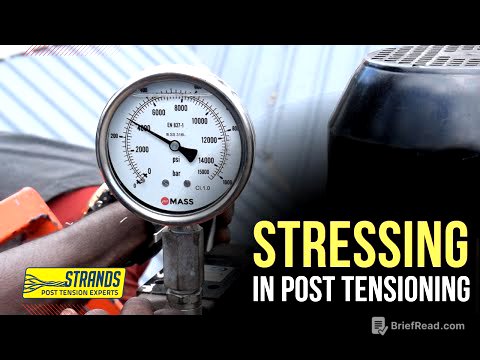TLDR;
This video provides a comprehensive guide to first aid and prevention of unintentional injuries. It covers the definition, objectives, and principles of first aid, as well as the characteristics of a good first aider. The video also details emergency action principles, vital sign checking, wound management, and specific first aid procedures for various injuries like fractures, dislocations, sprains, heat exhaustion, choking, drowning, heart attack, burns, stroke, and more. Additionally, it explains different methods of transporting injured victims.
- Definition, objectives, and principles of first aid
- Emergency action principles and vital sign checking
- Wound management and specific first aid procedures for various injuries
- Methods of transporting injured victims
Introduction to First Aid [0:15]
The lesson introduces the importance of first aid and prevention for unintentional injuries, emphasizing that prevention is better than cure. It highlights that accidents can happen anywhere, making safety awareness crucial. The discussion aims to equip individuals with the necessary knowledge and skills to handle emergency situations, benefiting themselves, their loved ones, and their community. The video will cover modules 1 and 2 in health, focusing on first aid and prevention for different unintentional injuries.
Defining First Aid and the Role of a First Aider [1:44]
First aid is defined as the immediate and temporary care given to someone who becomes ill or injured, including self-help and home care when medical assistance is unavailable or delayed. It can be life-saving in critical situations, but it's important to recognize its limits to avoid causing more harm. A first aider acts as a bridge between the victim and the physician, providing care until professional medical services begin. The main objectives of first aid are to save lives, prolong life, alleviate suffering, and prevent further injury.
Characteristics and Principles of a First Aider [2:59]
A good first aider should be gentle, observant, resourceful, tactful, and sympathetic. Being gentle means avoiding causing pain or panic, while being observant involves noticing all signs of injury or illness. Resourcefulness means making the best use of available resources, tactfulness means not frightening the victim, and sympathy involves comforting and reassuring them. Key "do's" in first aid include staying calm, reassuring the victim, checking for medical bracelets, loosening tight clothing, and keeping the victim covered to reduce shock. Things to avoid include giving food or drink to an unconscious person and moving an injured person unless necessary for their safety.
Emergency Action Principles [4:21]
When encountering an emergency, first ensure the scene is safe. If unsafe, call emergency medical services instead of approaching the accident. Ensure the victim is lying on their back; if not, carefully roll them over. Check for responsiveness by gently tapping their shoulder and asking if they are okay. If there is no response, call for help immediately. Perform a primary survey using the acronym ABC: Airway (check for and remove any blockage), Breathing (use the head-tilt/chin-lift method to check for breathing; if absent, perform rescue breathing), and Circulation (check for a carotid pulse; if absent, proceed to CPR).
CPR and Secondary Survey [5:50]
To perform CPR, apply the head-tilt/chin-lift method, pinch the nose, and give two initial full breaths. Remove any clothing blocking the compression area and perform CPR with 5 cycles of 30 compressions and 2 breaths. If the victim revives, conduct a secondary survey; if not, continue CPR while waiting for the rescue team. For a conscious victim, perform the secondary survey, record all data, and hand over to the rescue team. Interview the victim using the acronym SAMPLE: Allergies, Medications, Past medical history, Last oral intake, and Events prior to the accident.
Checking Vital Signs [7:07]
Carefully check vital signs, including the eyes (dilated pupils may indicate shock, constricted pupils may indicate stroke or drug abuse, unequal pupils may indicate stroke or head injuries), nose (watery discharge may indicate fracture or skull injury), and skin color (bluish color may indicate lack of oxygen or cyanosis). Also, check body temperature and blood pressure. Perform a head-to-toe examination, looking for deformities, contusions, abrasions, punctures, burns, tenderness, lacerations, and swelling (DCAP-BTLS).
Checking Pulse, Temperature, and Respiration [8:11]
To check the pulse, use your fingertips over an artery, avoiding the thumb. Do not palpate both carotid arteries simultaneously or take the pulse when the victim is sitting. Normal pulse rates vary by age and gender. Monitor temperature using a thermometer rectally, orally, or through the armpits, especially in cases of stroke and high fever. Count the number of breaths per minute to check respiration; normal rates vary by age. Note any unusual sounds like wheezing or gurgling, which may indicate specific conditions.
Skin Color and Head-to-Toe Examination [11:30]
Skin color reflects blood circulation and oxygen saturation. Mucous around the mouth, inner eyelids, and nail beds indicates poor circulation. A healthy skin is warm and pink. During a head-to-toe examination, check for lacerations, contusions, and blood in the hair, indicating potential head injuries. Note any fluid in the nose and ears, which may suggest a skull fracture. Pay close attention to the pupils, noting size and reactivity, as these can indicate shock, poisoning, head injury, or death.
Chest, Abdomen, and Back Examination [13:08]
Examine the chest for cuts, bruises, and penetrations. Pain upon pressure may indicate a rib fracture. For the abdomen, check for pain, tenderness, and lumps, seeking immediate medical assistance if any are found. Assess the back for movement and sensation in the lower extremities. If movement and sensation are present, immobilize the victim. Differentiate between signs (objective details discovered through senses) and symptoms (subjective sensations described by the victim). Primary survey is for unconscious victims to treat life-threatening conditions, while secondary survey is for conscious or revived victims to detect all aspects of their condition.
Dressings and Bandages [15:14]
A dressing is a sterile cloth covering a wound to prevent infection and stop bleeding. Apply dressings by washing hands, wearing gloves, and avoiding touching the wound. Use a dressing large enough to extend beyond the wound edges and secure it with a bandage or tape. Compresses, either cold or hot, reduce swelling and relieve pain, especially for sprains and strains. Bandages apply pressure to bleeding, cover wounds and burns, and support immobilization for broken bones, sprains, and strains. Types of bandages include triangular, ace, and tubular.
Triangular Bandage and Bandaging Techniques [17:16]
A triangular bandage can be used as a cold compress, padding, support for pressure, or as a sling. It has two faces: open and cravat. The open face is for wounds on the head, chest, back, hand, and foot, while the cravat face is for wounds needing extra support, like those on the eye, forehead, or ankle. When bandaging, always use a square knot, keep the cloth sterile, and ensure the ends are secure. Bandage firmly over bleeding and securely over broken bones, but not so tight as to cut off circulation. Regularly check for comfort and secure the bandage with tape, clips, or a knot, ensuring knots do not touch the skin.
Wounds: Types and Treatment [19:50]
A wound is a break in the continuity of body tissue, either closed (hematoma or contusion) or open. Open wounds include puncture (piercing by pointed objects), abrasion (scraping), incision (cut by sharp objects), laceration (tearing of soft tissues), and avulsion (forcible tearing away of tissues). For hematomas, use the mnemonic RICE: Rest, Ice, Compression, and Elevation. For open wounds with severe bleeding, wear gloves, expose the wound, control bleeding with direct pressure, elevate the injured part (except for eye injuries or embedded objects), cover with sterile dressing and bandage, care for shock, and consult a physician immediately.
Unintentional Injuries: Fractures and Dislocations [22:04]
Unintentional injuries are caused by accidents. A fracture is a break or crack in a bone, either open (piercing the skin) or closed (skin intact). First aid involves checking vital signs, not moving the injured part, stopping bleeding, immobilizing the broken part with splinting, and seeking immediate medical help. A dislocation is a partial or complete displacement of bones. First aid includes calling for help, splinting the affected part, not attempting to move the dislocated part, and applying ice to reduce swelling.
Sprains, Strains, and Heat Exhaustion [23:26]
A sprain is an injury to the ligaments of a bone due to tearing or over-stretching, while a strain is an injury to the muscles from improper use. First aid for both involves resting the injured part, applying ice, compressing the injured part, and elevating it. Heat exhaustion is caused by loss of salt and water due to high temperature, potentially leading to heat stroke and death. First aid includes moving the victim to a cooler place, giving them water, checking vital signs, and seeking medical help.
Food Poisoning, Choking, and Drowning [24:23]
Food poisoning results from consuming contaminated food or drink. First aid involves helping the person lie down and rest, giving them flavorless fluids, providing a bowl for vomiting, and calling for medical help if the condition worsens. Choking occurs when a foreign object blocks the throat. First aid includes encouraging the person to cough, giving five back blows, and performing abdominal thrusts. If obstruction persists, call for an ambulance. Drowning happens when air cannot enter the lungs due to water. First aid includes laying the person on their back, checking breathing, opening the airway, giving rescue breaths and chest compressions if necessary, placing them in the recovery position if breathing, and treating for hypothermia.
Heart Attack, Chemical Burns, and Burns [26:44]
A heart attack is caused by a sudden obstruction of blood supply to the heart muscles. First aid involves helping the person sit or lie down with their head elevated, calling for medical help, giving them aspirin, and monitoring vital signs. Be prepared to give rescue breaths and chest compressions. Chemical burns require breaking contact with the electrical source, flooding the injury sites with cold water, wearing gloves, placing a sterile dressing over the burn, calling for medical help, reassuring the victim, and treating for shock. For minor burns, flood the area with cold water and cover with a sterile dressing. For severe burns, prevent contact with the ground, douse with cold liquid, seek medical assistance, remove jewelry and smoldering clothing, cover the burned area, monitor vital signs, reassure the casualty, and treat for shock.
Heat Stroke and Stroke [29:06]
Heat stroke is caused by a failure of the brain's thermostat to regulate body temperature. First aid involves moving the person to a cold place, removing outer clothing, calling for medical help, wrapping them in a cold wet sheet, and monitoring vital signs. If temperature rises, repeat the cooling process. Stroke occurs when blood supply to the brain is impaired. If conscious, help the person lie down with their head and shoulders raised, incline their head to the affected side, and call for help. Loosen tight clothing, monitor vital signs, and reassure the victim. If unconscious, give rescue breathing and chest compressions and call for an ambulance.
Transporting a Victim [30:42]
Transporting an injured person requires great care and proper training. Factors to consider include the victim's weight and height, status (conscious or unconscious), environment safety, and special needs like injuries. One-man transport methods include the fireman's carry, piggyback, backstrap carry, fireman's drag, and blanket drag. Two-man carries include the chair or seat carry. Three or more-man transports include the hammock carry, bearer alongside carry, and six-man lift and carry.
Conclusion [33:05]
Unintentional injuries are unavoidable and can happen to anyone at any time. Practicing safety awareness is crucial. When injuries occur, knowledge and skills in first aid can alleviate pain, prevent further injury, prolong life, and even save lives. The lesson concludes with a reminder to complete the activities in health modules 1 and 2.









